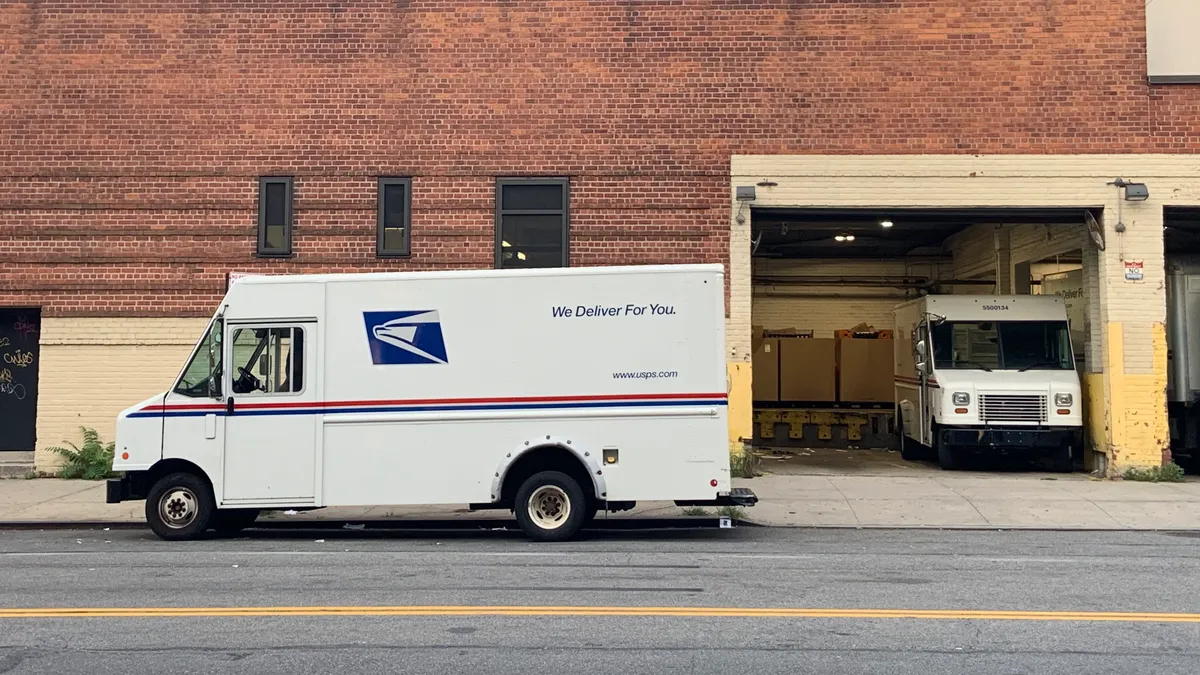U.S. parcel delivery demand fell back to earth in 2022, leaving top carriers like FedEx scrambling to cut costs and readjust their networks for an uncertain future.
Data released Tuesday from the Pitney Bowes Parcel Shipping Index outlines the extent of these volume declines, along with which delivery providers fared the best in a difficult environment.
Here are five charts based on that data, covering trends such as UPS and Amazon's decoupling, the growth of regional carriers and what lies ahead for the delivery sector.
Parcel volumes fell, but revenues increased
After years of growth, U.S. parcel volumes declined 2.2% from 2021 to 2022, according to the index. Carriers struggled to beat tough year-over-year comparisons as e-commerce demand cooled off following a surge from the COVID-19 pandemic.
Delivery providers' pricing power remained firm despite lower volumes. U.S. parcel revenues grew 6.5% YoY, which Pitney Bowes said was driven by inflation and higher fuel surcharges. Vijay Ramachandran, the company’s vice president of go-to-market enablement and experience, pointed out additional reasons for the divergence between volumes and revenues.
Many consumers with high spending power moved from the cities to suburban and exurban areas, increasing the cost to deliver to them. Additionally, carriers spent heavily to expand their capacity after many networks were overwhelmed by a flood of packages when the pandemic first took hold. Now, they're pushing to recoup their investment and continue to increase rates.
"I think these additional logistics costs are really paying for the investment that happened a couple years ago," Ramachandran said.
Carriers boost revenues despite declining demand
FedEx saw the steepest volume drop, Amazon momentum stops
FedEx had the largest percentage jump in U.S. volumes among the top parcel carriers in 2021, and it followed up that performance in 2022 with the sharpest overall decline.
This swing underscores the turbulence Raj Subramaniam has encountered in the beginning of his tenure as FedEx CEO, with plummeting demand driving the company to slash costs to reduce pressure on its bottom line. UPS and the U.S. Postal Service also encountered volume declines in 2022 in a softening demand environment.
Amazon Logistics' volume remained flat, a pronounced slowdown from the blistering pace of growth the e-commerce giant's in-house delivery arm saw the previous six years. The company has closed and canceled dozens of warehouses to reduce the burden of fixed costs while better matching capacity to demand.
Top carriers bore the brunt of softening delivery activity
UPS charts a separate path from top customer
While UPS fared better than rival FedEx in terms of volume loss last year, it has ceded the most market share among carriers since 2016, per the index. Meanwhile, its top customer Amazon has seen its market share by volume grow significantly during that period.
What changed? The relationship between the two companies, for one.
UPS has prioritized attracting more profitable shipper segments rather than customers like Amazon, which offer plenty of volume but at low margins. Meanwhile, Amazon has built up its own logistics capabilities to deliver more of its customers' orders in-house, reducing its reliance on third-party carriers.
“We’ll continue on a mutually agreed path to glide that business down in 2023,” UPS CFO Brian Newman said of Amazon on a Jan. 31 earnings call.
This gradual shift has resulted in many deliveries that would have originally gone to UPS being completed by Amazon instead.
Amazon bites into UPS' share of parcel sector
Smaller carriers continue momentum
After nearly doubling their package volume in 2021, smaller U.S. parcel carriers again saw strong growth in 2022 despite a more challenging environment. Volume and revenue for carriers outside of UPS, FedEx, the Postal Service and Amazon grew by roughly 25% and 29%, respectively, YoY.
Alternatives to the top carriers have seen strong interest from shippers seeking lower delivery rates and insurance against capacity constraints. They have also expanded their coverage areas and leveraged partnerships with software providers and shipping platforms to boost their customer reach.
These delivery providers — including LaserShip/OnTrac, Lone Star Overnight and Spee-Dee Delivery — still have a long way to go to rival FedEx and UPS, as they made up just 2% of market share by volume combined last year. They may also have trouble attracting customers in a challenging economic climate, as volume discounts from national carriers become more appealing.
"[Carrier] diversification is a risk-mitigation strategy, but it may not be a cost-saving strategy," said Pitney Bowes' Ramachandran.
Delivery alternatives saw further growth in 2022
Volume growth expected to slow down
Macroeconomic uncertainty, inflationary pressures and market normalization after COVID-19 are all poised to weigh on U.S. parcel volume growth going forward, according to the index. It forecasts a compound annual growth rate of 5% from 2023 to 2028 as the most likely scenario, down from 10.8% CAGR between 2016 and 2022.
This rate would result in roughly 28 billion parcels in the U.S. market in 2028, although the index projects that volumes could end up being as low as 24 billion or as high as 32 billion. A key factor in the end result will be e-commerce activity, which remains strong even amid the current cooldown, said Ramachandran. Parcel volumes are a full year ahead of the index’s pre-pandemic forecasts.
"What that means is that there is some staying power to online shopping, online penetration, direct-to-consumer shipping and delivery, and it hasn’t reverted back to the mean of where we thought things were going to be," he said.





















